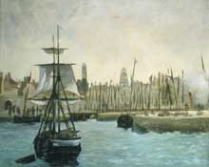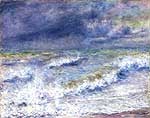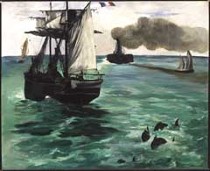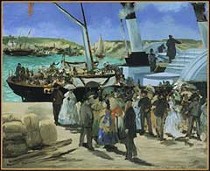 There’s such a level of silliness to the Art Museum’s insistence on Edouard Manet’s obsession with the sea that it’s hard to take some of the blather that goes with the show too seriously (You can also check out Roberta’s post on her experience at Manet and the Sea).
There’s such a level of silliness to the Art Museum’s insistence on Edouard Manet’s obsession with the sea that it’s hard to take some of the blather that goes with the show too seriously (You can also check out Roberta’s post on her experience at Manet and the Sea).Nonetheless, the show itself is worth taking seriously, mainly because the Manet’s are gorgeously painted, with slurpy, calm brush strokes that put to shame so many of his contemporaries, with their agitation of paint and surface (shown left, Auguste Renoir’s “Seascape”*).
 I mean, how silly is it to include that “Still Life With Fish” of Manet, on the mere pretext that the fish and the oysters come from THE SEA. Duh. But what I did find instructive was the quote from Manet in the recording (I broke my rule of never listening to the recording, since I was there alone), explaining the importance of making the background just, well, background, and of painting the fish with a few strokes to suggest, not delineate, the scales.
I mean, how silly is it to include that “Still Life With Fish” of Manet, on the mere pretext that the fish and the oysters come from THE SEA. Duh. But what I did find instructive was the quote from Manet in the recording (I broke my rule of never listening to the recording, since I was there alone), explaining the importance of making the background just, well, background, and of painting the fish with a few strokes to suggest, not delineate, the scales.
Which brings me to the sea paintings, which to my eye were less about the sea than the boats, and less about the boats than about boats as metaphor–for humans, for life, for safety in the face of nature.
 The sea is the face of nature, even when it’s becalmed. The sea, in the late 1800s, and even today, is a world that humankind hasn’t transformed with buildings, gardens, factories (see “The Port of Calais” at top) –although “The Steamboat, Seascape and Porpoises” (shown) seems to be troubled by the possibility that that steamboat, a black blot belching smoke, may indeed transform the sea’s natural stronghold into another man-defiled kingdom. The beautiful sailing ship, closer in and painted with delight, the wind pressing air into the sails, stands in elegant contrast to the steamboat.
The sea is the face of nature, even when it’s becalmed. The sea, in the late 1800s, and even today, is a world that humankind hasn’t transformed with buildings, gardens, factories (see “The Port of Calais” at top) –although “The Steamboat, Seascape and Porpoises” (shown) seems to be troubled by the possibility that that steamboat, a black blot belching smoke, may indeed transform the sea’s natural stronghold into another man-defiled kingdom. The beautiful sailing ship, closer in and painted with delight, the wind pressing air into the sails, stands in elegant contrast to the steamboat.
The interest in the boats is clear from the careful draughtsmanship and hard edges; the sea also serves as a metaphor in these paintings–for planet earth. This thought is especially clear in “Sailing Ships at Sea,” with its curved horizon line. The sea painting is less about the way the sea looks as about a kind of background and milieu for the boats.
 I don’t think Manet was as interested in the sea, per se, but rather about man’s place in the world and about men as social beings (shown, “The Folkestone Boat, Boulogne”**). I think the sea paintings reflect those interests more than they reflect an interest in the sea.
I don’t think Manet was as interested in the sea, per se, but rather about man’s place in the world and about men as social beings (shown, “The Folkestone Boat, Boulogne”**). I think the sea paintings reflect those interests more than they reflect an interest in the sea.
Which is not to say that the sea is not of any interest. This comment is just my way of putting balance back into what seemed to me a sort of curatorial desperation to justify the show.
And that’s not to say that I think the show needs justifying. It’s just to say that the curators must have thought so.
*from Art Institute of Chicago’s Potter Palmer Collection
**from Philadelphia Museum of Art’s Mr. & Mrs. Carroll S. Tyson Jr. Collection









